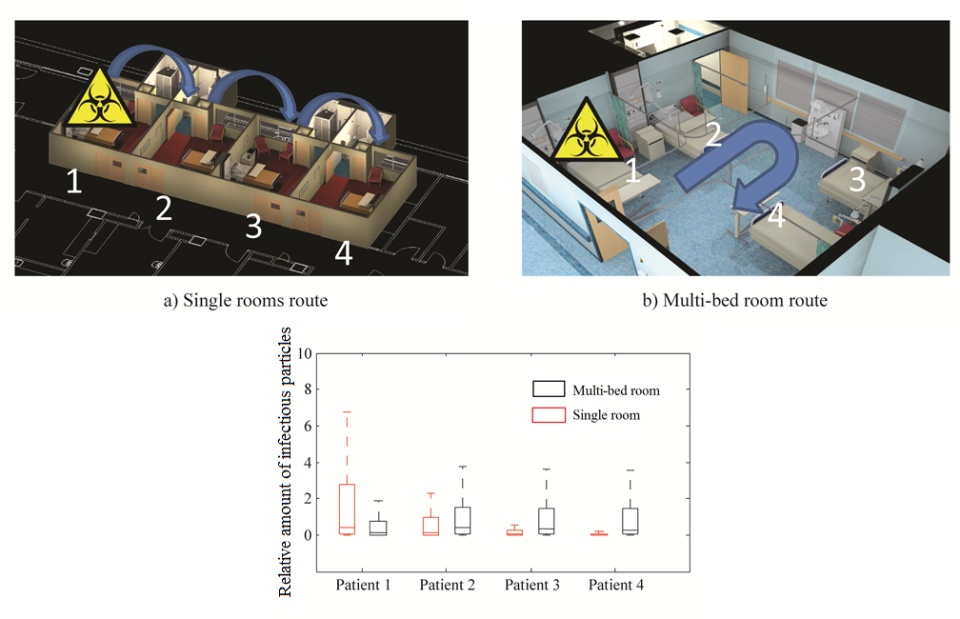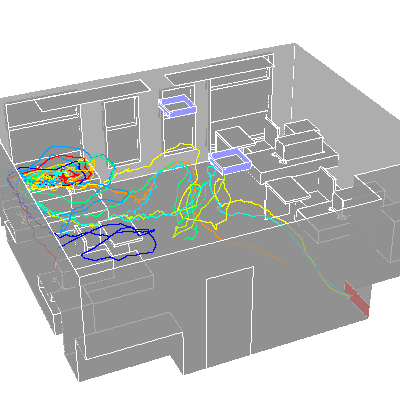These Freaky Graphics Show How Quickly Germs Can Spread in a Hospital
It’s no secret that there are germs in hospitals, but a new research-backed graphic has shown just how quickly they can spread.
Marco-Felipe King, PhD, a research fellow at the University of Leeds in the UK, created GIFs that detail how hospital rooms can host germs that quickly spread around the room, where they can infect others.
King based his graphics on research he conducted on hygiene in multi-patient and single-patient hospital rooms. The research was published in the journal Indoor Air earlier this year.
For his work, King and his colleagues used a test facility at the University of Leeds to make a replica of a hospital room and released some bacteria to see where it went.
Among his findings: Surfaces were contaminated meters away from the source instead of being removed by the room’s ventilation system. Where a patient with an infectious disease is relative to the room’s air ventilation system also matters, and can impact the distribution of germs in the room, he found.

Simulation of a airflow in a four-bed hospital room, colored by temperature. The blue beds show where patients are, while the figure in the middle represents the doctor. (Courtesy of Dr. Amir Khan, School of Civil Engineering, University of Leeds)
He also discovered that health care workers have fewer germs on their hands when they work with a patient in a single room versus when they work with several patients in one room. Essentially, walls help protect patients from the germs of other patients.

The prediction of hand contamination by bacteria of nurses from surface contacts after typical patient care for four patients in separate single rooms (left) vs. four patients in a four-bed room (right). The graph at bottom shows the decreasing trend of contamination after dealing with the infectious patient in the single room (due to bacteria being removed from hand-washing), but the increasing trend of the same care in a four-bed room due to surface contamination. (Graphics courtesy of Marco-Felipe King, PhD)

This figure shows how infectious droplets released by a hospital patient in a four-bed room contaminates the surfaces of nearby patients. (Graphic courtesy of Marco-Felipe King, PhD)
King tells Yahoo Health that he wanted to conduct his study to “challenge the myth that tiny infectious droplets released by patients’ coughing, sneezing, or breathing are fully dealt with by the ventilation system.”
Related: The Disgusting Disease That’s On The Bottom Of Your Shoes
While the news — and corresponding graphics — are freaky, board-certified infectious disease specialist Amesh A. Adalja, MD, an assistant professor at the University of Pittsburgh Medical Center, isn’t shocked by the findings.
“A long-standing risk of going to the hospital is that you might acquire an infection while you’re there,” he tells Yahoo Health. “Everything can spread really easily in hospitals.”
Adalja says certain infections thrive in hospital environments, including C. difficile bacteria (it can cause fever, diarrhea, and abdominal pain), norovirus (which causes acute stomach issues and vomiting), and MRSA (the drug-resistant bacteria that causes staph infections).
Related: 12 Germs That Cause Food Poisoning
It’s not the fault of the hospitals, per se, Adalja says — it’s just due to what happens within them. Visitors come in and out, and patients may have IV lines, catheters, or open wounds that leave them especially prone to infection. And, of course, the ventilation can move germs around.
But Adalja says there are a few things you can do to lower your odds of getting an infection. The first is to visit your primary care physician whenever possible and avoid a hospital stay altogether. “From an infectious disease and cost standpoint, you don’t want to be in the hospital if you can avoid it,” says Adalja.
Of course, that’s not always possible. In those cases, he recommends asking your caregivers if they’ve washed their hands (“no doctor should be offended by that question,” he says), as well as visitors. If you’re visiting someone in the hospital, be sure to wash your hands before and after your visit, since surfaces that you may touch can become contaminated as well.
Preventive care is important, too. Adalja recommends getting an annual flu shot to lower the odds you’ll contract the disease during a hospital stay.
Despite his findings, King stresses that hospitals are “safe places and provide excellent patient care.” (Just maybe be mindful of where the vents are located.)
Read This Next: Right Now, Germs Are Spreading Through Your Office Like Wildfire

